Case Study: Analyzing Debt Redemption and Financial Strategy at Macy's
VerifiedAdded on 2023/04/26
|10
|1752
|323
Case Study
AI Summary
This case study provides a financial analysis of Macy's Inc., focusing on its debt redemption activities in 2017. It examines the amount of debt redeemed at maturity and early extinguishments, detailing specific debts and patterns in Macy's debt management strategy. The analysis includes journal entries for debt redemption, early extinguishment, and interest attributable to long-term debt, as well as calculations for the loss on extinguishment. The study concludes that Macy's has shown improvement in its capital structure and debt repayment compared to previous years, strategically managing its debts with profits and incoming cash flows to maintain long-term financial health. The assignment includes computations regarding the loss on extinguishment, amortization of discount, and journal entries related to debt and interest expenses.

0
Running head: FINANCE
FINANCE
Name of the Student
Name of the University
Author’s Note
Running head: FINANCE
FINANCE
Name of the Student
Name of the University
Author’s Note
Secure Best Marks with AI Grader
Need help grading? Try our AI Grader for instant feedback on your assignments.
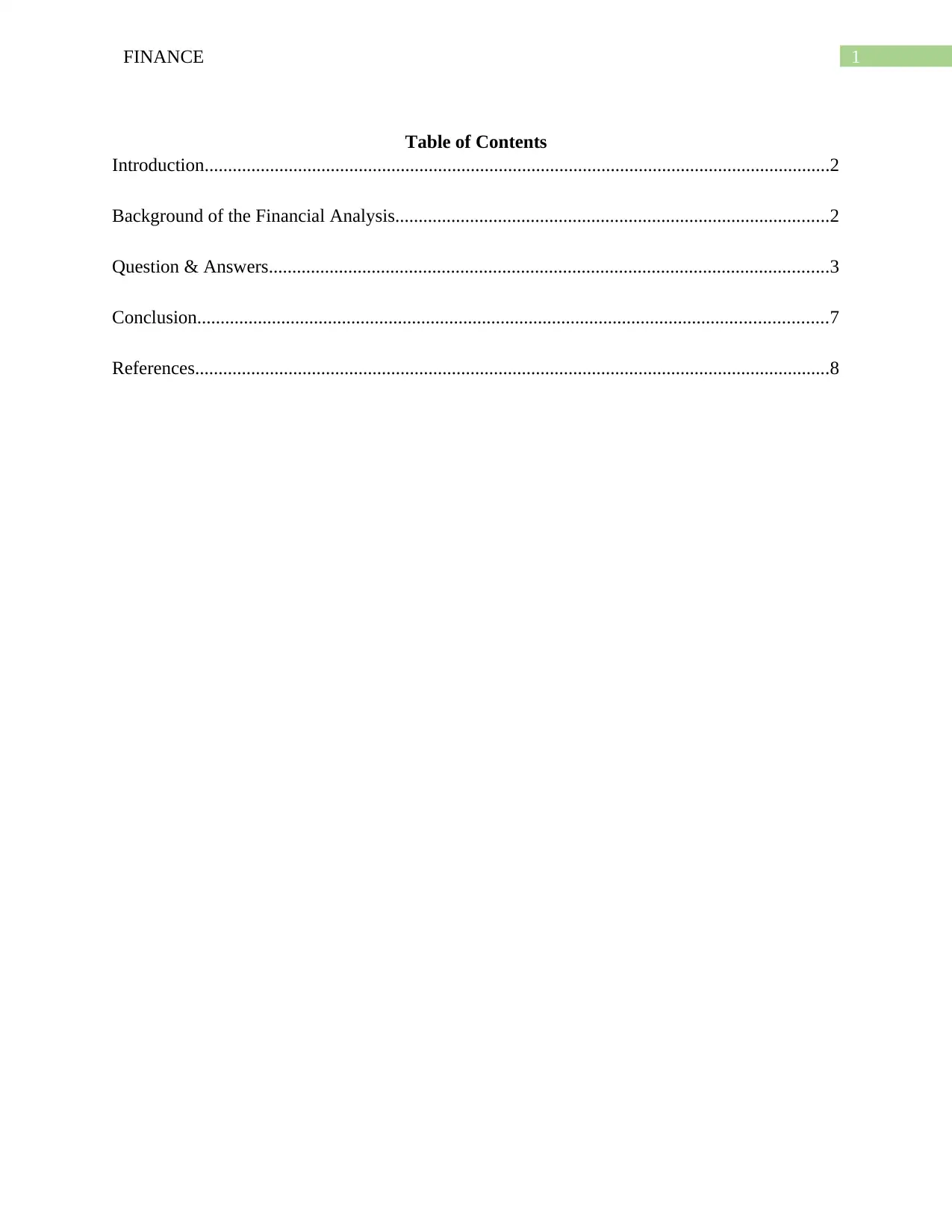
1FINANCE
Table of Contents
Introduction......................................................................................................................................2
Background of the Financial Analysis.............................................................................................2
Question & Answers........................................................................................................................3
Conclusion.......................................................................................................................................7
References........................................................................................................................................8
Table of Contents
Introduction......................................................................................................................................2
Background of the Financial Analysis.............................................................................................2
Question & Answers........................................................................................................................3
Conclusion.......................................................................................................................................7
References........................................................................................................................................8
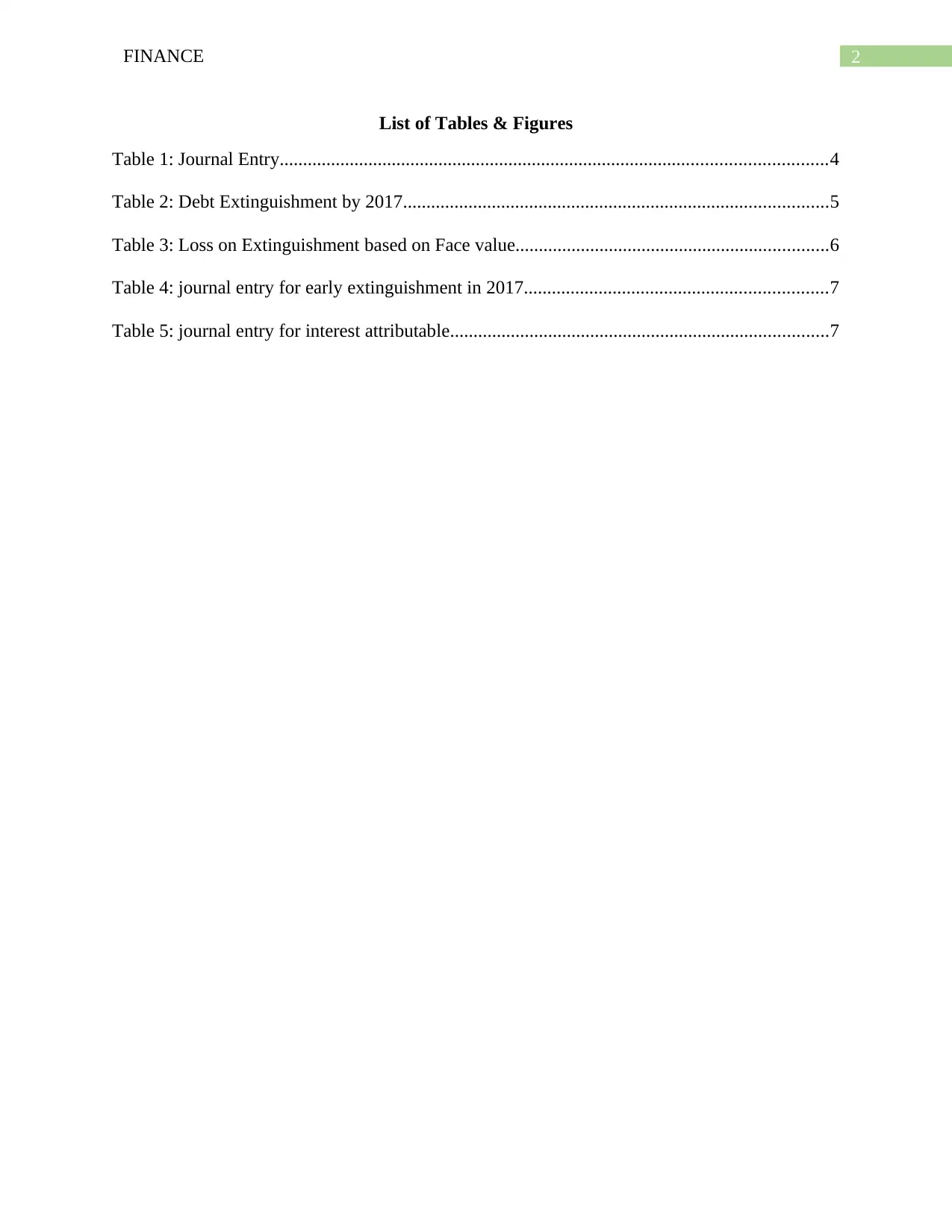
2FINANCE
List of Tables & Figures
Table 1: Journal Entry.....................................................................................................................4
Table 2: Debt Extinguishment by 2017...........................................................................................5
Table 3: Loss on Extinguishment based on Face value...................................................................6
Table 4: journal entry for early extinguishment in 2017.................................................................7
Table 5: journal entry for interest attributable.................................................................................7
List of Tables & Figures
Table 1: Journal Entry.....................................................................................................................4
Table 2: Debt Extinguishment by 2017...........................................................................................5
Table 3: Loss on Extinguishment based on Face value...................................................................6
Table 4: journal entry for early extinguishment in 2017.................................................................7
Table 5: journal entry for interest attributable.................................................................................7
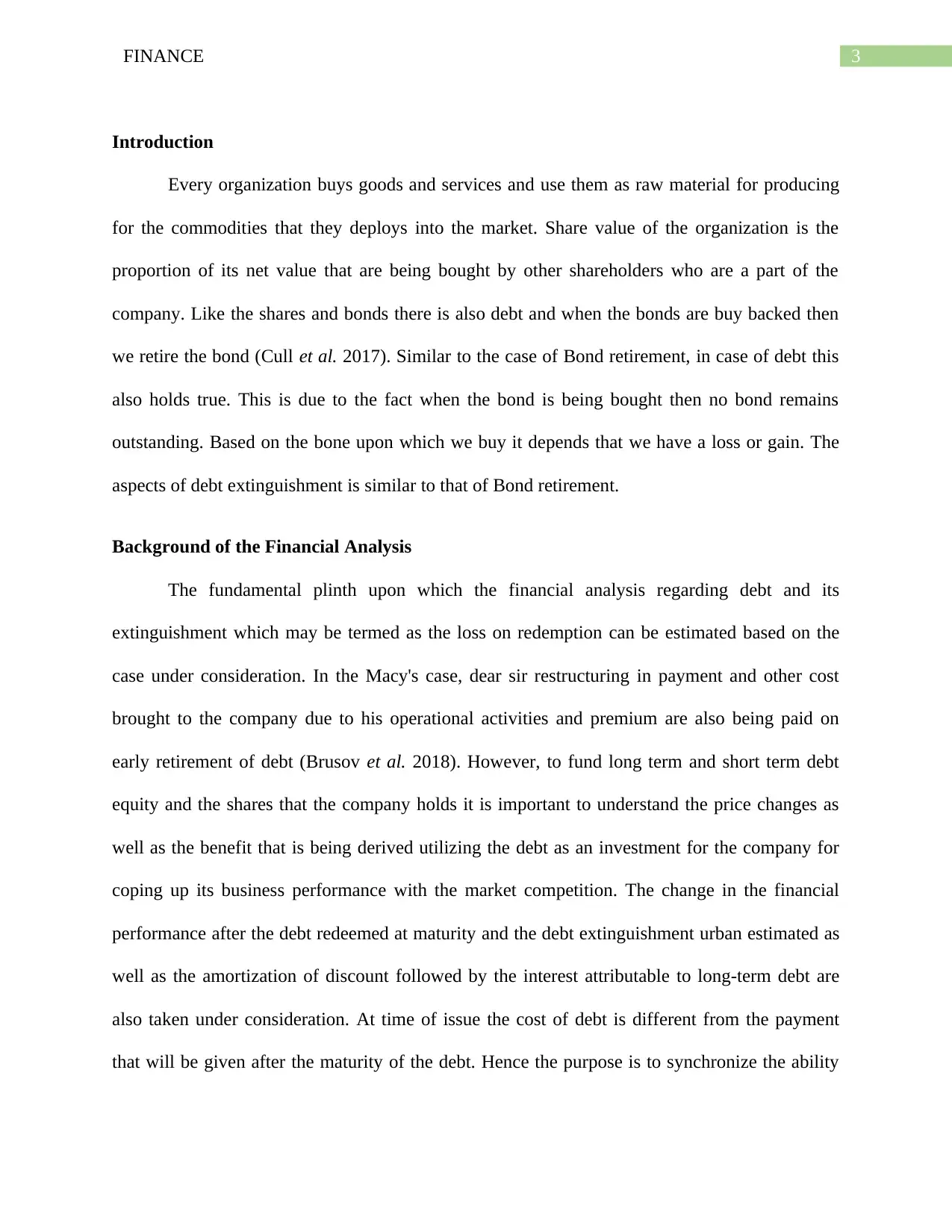
3FINANCE
Introduction
Every organization buys goods and services and use them as raw material for producing
for the commodities that they deploys into the market. Share value of the organization is the
proportion of its net value that are being bought by other shareholders who are a part of the
company. Like the shares and bonds there is also debt and when the bonds are buy backed then
we retire the bond (Cull et al. 2017). Similar to the case of Bond retirement, in case of debt this
also holds true. This is due to the fact when the bond is being bought then no bond remains
outstanding. Based on the bone upon which we buy it depends that we have a loss or gain. The
aspects of debt extinguishment is similar to that of Bond retirement.
Background of the Financial Analysis
The fundamental plinth upon which the financial analysis regarding debt and its
extinguishment which may be termed as the loss on redemption can be estimated based on the
case under consideration. In the Macy's case, dear sir restructuring in payment and other cost
brought to the company due to his operational activities and premium are also being paid on
early retirement of debt (Brusov et al. 2018). However, to fund long term and short term debt
equity and the shares that the company holds it is important to understand the price changes as
well as the benefit that is being derived utilizing the debt as an investment for the company for
coping up its business performance with the market competition. The change in the financial
performance after the debt redeemed at maturity and the debt extinguishment urban estimated as
well as the amortization of discount followed by the interest attributable to long-term debt are
also taken under consideration. At time of issue the cost of debt is different from the payment
that will be given after the maturity of the debt. Hence the purpose is to synchronize the ability
Introduction
Every organization buys goods and services and use them as raw material for producing
for the commodities that they deploys into the market. Share value of the organization is the
proportion of its net value that are being bought by other shareholders who are a part of the
company. Like the shares and bonds there is also debt and when the bonds are buy backed then
we retire the bond (Cull et al. 2017). Similar to the case of Bond retirement, in case of debt this
also holds true. This is due to the fact when the bond is being bought then no bond remains
outstanding. Based on the bone upon which we buy it depends that we have a loss or gain. The
aspects of debt extinguishment is similar to that of Bond retirement.
Background of the Financial Analysis
The fundamental plinth upon which the financial analysis regarding debt and its
extinguishment which may be termed as the loss on redemption can be estimated based on the
case under consideration. In the Macy's case, dear sir restructuring in payment and other cost
brought to the company due to his operational activities and premium are also being paid on
early retirement of debt (Brusov et al. 2018). However, to fund long term and short term debt
equity and the shares that the company holds it is important to understand the price changes as
well as the benefit that is being derived utilizing the debt as an investment for the company for
coping up its business performance with the market competition. The change in the financial
performance after the debt redeemed at maturity and the debt extinguishment urban estimated as
well as the amortization of discount followed by the interest attributable to long-term debt are
also taken under consideration. At time of issue the cost of debt is different from the payment
that will be given after the maturity of the debt. Hence the purpose is to synchronize the ability
Secure Best Marks with AI Grader
Need help grading? Try our AI Grader for instant feedback on your assignments.
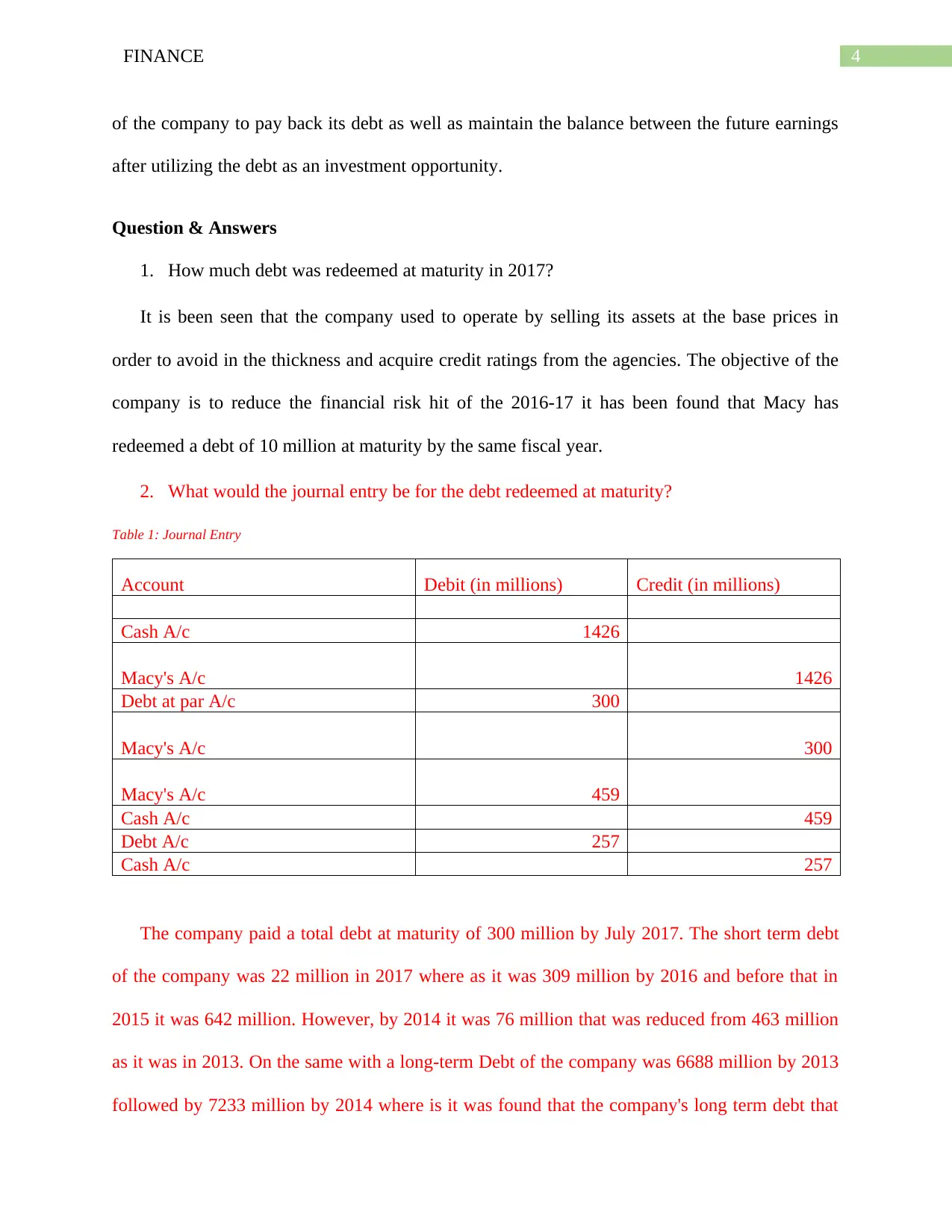
4FINANCE
of the company to pay back its debt as well as maintain the balance between the future earnings
after utilizing the debt as an investment opportunity.
Question & Answers
1. How much debt was redeemed at maturity in 2017?
It is been seen that the company used to operate by selling its assets at the base prices in
order to avoid in the thickness and acquire credit ratings from the agencies. The objective of the
company is to reduce the financial risk hit of the 2016-17 it has been found that Macy has
redeemed a debt of 10 million at maturity by the same fiscal year.
2. What would the journal entry be for the debt redeemed at maturity?
Table 1: Journal Entry
Account Debit (in millions) Credit (in millions)
Cash A/c 1426
Macy's A/c 1426
Debt at par A/c 300
Macy's A/c 300
Macy's A/c 459
Cash A/c 459
Debt A/c 257
Cash A/c 257
The company paid a total debt at maturity of 300 million by July 2017. The short term debt
of the company was 22 million in 2017 where as it was 309 million by 2016 and before that in
2015 it was 642 million. However, by 2014 it was 76 million that was reduced from 463 million
as it was in 2013. On the same with a long-term Debt of the company was 6688 million by 2013
followed by 7233 million by 2014 where is it was found that the company's long term debt that
of the company to pay back its debt as well as maintain the balance between the future earnings
after utilizing the debt as an investment opportunity.
Question & Answers
1. How much debt was redeemed at maturity in 2017?
It is been seen that the company used to operate by selling its assets at the base prices in
order to avoid in the thickness and acquire credit ratings from the agencies. The objective of the
company is to reduce the financial risk hit of the 2016-17 it has been found that Macy has
redeemed a debt of 10 million at maturity by the same fiscal year.
2. What would the journal entry be for the debt redeemed at maturity?
Table 1: Journal Entry
Account Debit (in millions) Credit (in millions)
Cash A/c 1426
Macy's A/c 1426
Debt at par A/c 300
Macy's A/c 300
Macy's A/c 459
Cash A/c 459
Debt A/c 257
Cash A/c 257
The company paid a total debt at maturity of 300 million by July 2017. The short term debt
of the company was 22 million in 2017 where as it was 309 million by 2016 and before that in
2015 it was 642 million. However, by 2014 it was 76 million that was reduced from 463 million
as it was in 2013. On the same with a long-term Debt of the company was 6688 million by 2013
followed by 7233 million by 2014 where is it was found that the company's long term debt that
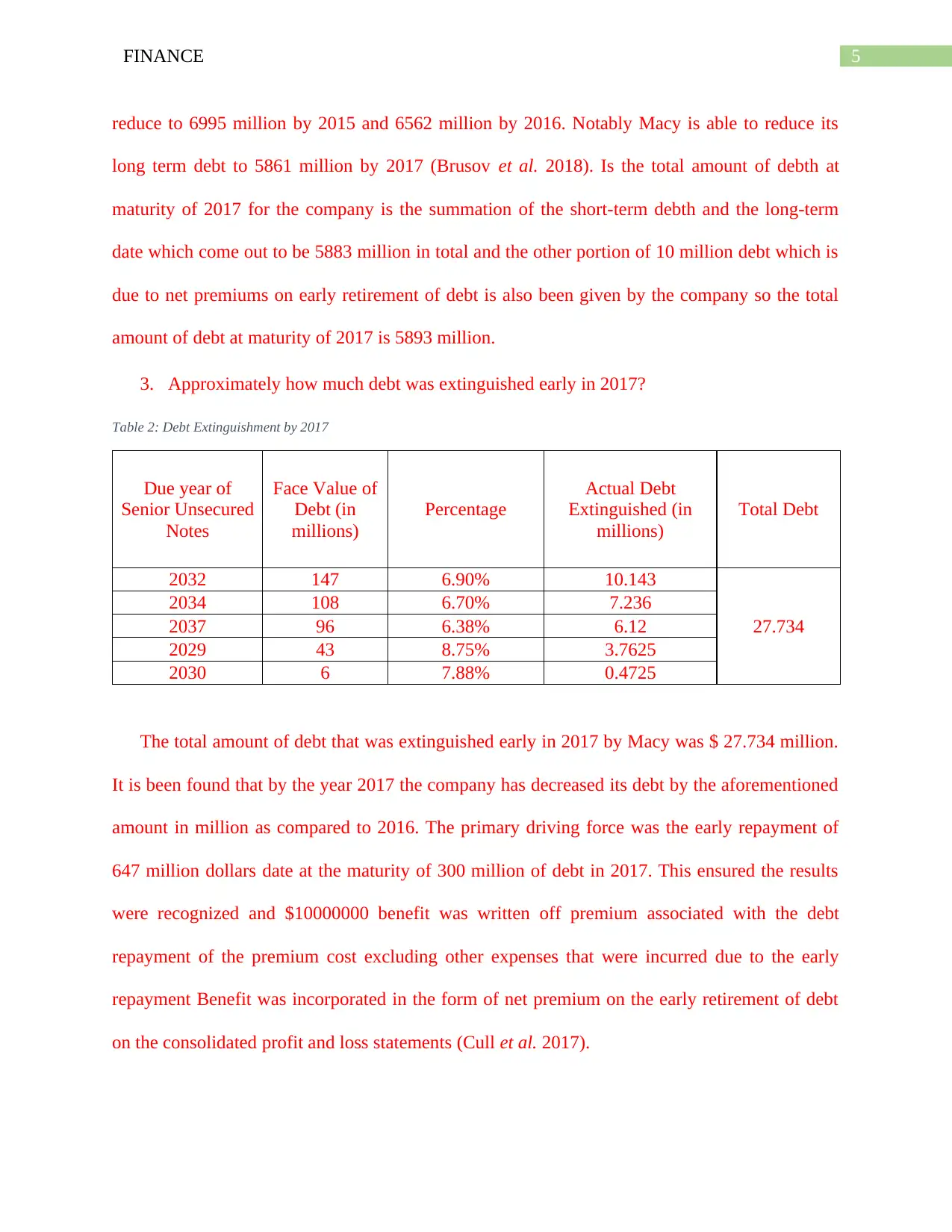
5FINANCE
reduce to 6995 million by 2015 and 6562 million by 2016. Notably Macy is able to reduce its
long term debt to 5861 million by 2017 (Brusov et al. 2018). Is the total amount of debth at
maturity of 2017 for the company is the summation of the short-term debth and the long-term
date which come out to be 5883 million in total and the other portion of 10 million debt which is
due to net premiums on early retirement of debt is also been given by the company so the total
amount of debt at maturity of 2017 is 5893 million.
3. Approximately how much debt was extinguished early in 2017?
Table 2: Debt Extinguishment by 2017
Due year of
Senior Unsecured
Notes
Face Value of
Debt (in
millions)
Percentage
Actual Debt
Extinguished (in
millions)
Total Debt
2032 147 6.90% 10.143
27.734
2034 108 6.70% 7.236
2037 96 6.38% 6.12
2029 43 8.75% 3.7625
2030 6 7.88% 0.4725
The total amount of debt that was extinguished early in 2017 by Macy was $ 27.734 million.
It is been found that by the year 2017 the company has decreased its debt by the aforementioned
amount in million as compared to 2016. The primary driving force was the early repayment of
647 million dollars date at the maturity of 300 million of debt in 2017. This ensured the results
were recognized and $10000000 benefit was written off premium associated with the debt
repayment of the premium cost excluding other expenses that were incurred due to the early
repayment Benefit was incorporated in the form of net premium on the early retirement of debt
on the consolidated profit and loss statements (Cull et al. 2017).
reduce to 6995 million by 2015 and 6562 million by 2016. Notably Macy is able to reduce its
long term debt to 5861 million by 2017 (Brusov et al. 2018). Is the total amount of debth at
maturity of 2017 for the company is the summation of the short-term debth and the long-term
date which come out to be 5883 million in total and the other portion of 10 million debt which is
due to net premiums on early retirement of debt is also been given by the company so the total
amount of debt at maturity of 2017 is 5893 million.
3. Approximately how much debt was extinguished early in 2017?
Table 2: Debt Extinguishment by 2017
Due year of
Senior Unsecured
Notes
Face Value of
Debt (in
millions)
Percentage
Actual Debt
Extinguished (in
millions)
Total Debt
2032 147 6.90% 10.143
27.734
2034 108 6.70% 7.236
2037 96 6.38% 6.12
2029 43 8.75% 3.7625
2030 6 7.88% 0.4725
The total amount of debt that was extinguished early in 2017 by Macy was $ 27.734 million.
It is been found that by the year 2017 the company has decreased its debt by the aforementioned
amount in million as compared to 2016. The primary driving force was the early repayment of
647 million dollars date at the maturity of 300 million of debt in 2017. This ensured the results
were recognized and $10000000 benefit was written off premium associated with the debt
repayment of the premium cost excluding other expenses that were incurred due to the early
repayment Benefit was incorporated in the form of net premium on the early retirement of debt
on the consolidated profit and loss statements (Cull et al. 2017).
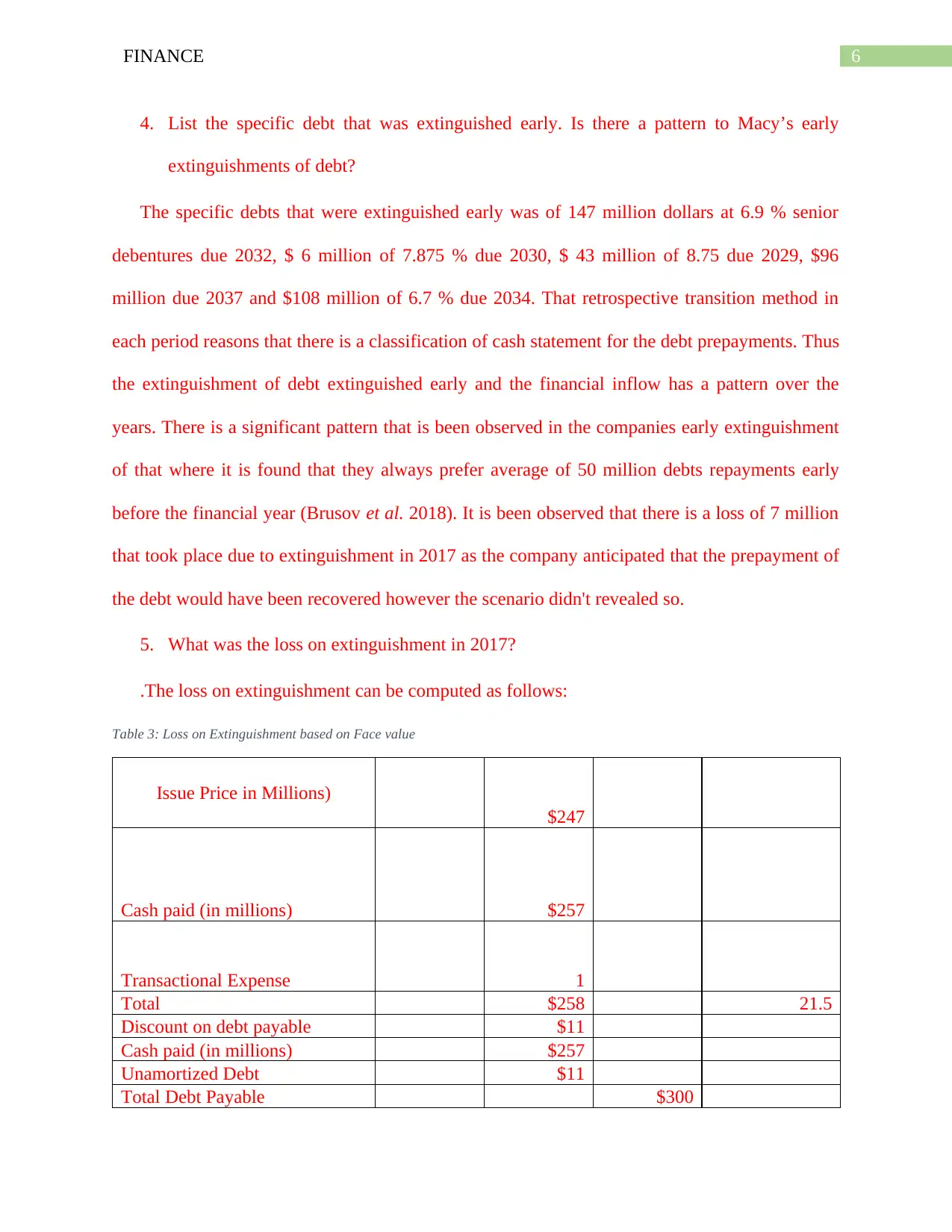
6FINANCE
4. List the specific debt that was extinguished early. Is there a pattern to Macy’s early
extinguishments of debt?
The specific debts that were extinguished early was of 147 million dollars at 6.9 % senior
debentures due 2032, $ 6 million of 7.875 % due 2030, $ 43 million of 8.75 due 2029, $96
million due 2037 and $108 million of 6.7 % due 2034. That retrospective transition method in
each period reasons that there is a classification of cash statement for the debt prepayments. Thus
the extinguishment of debt extinguished early and the financial inflow has a pattern over the
years. There is a significant pattern that is been observed in the companies early extinguishment
of that where it is found that they always prefer average of 50 million debts repayments early
before the financial year (Brusov et al. 2018). It is been observed that there is a loss of 7 million
that took place due to extinguishment in 2017 as the company anticipated that the prepayment of
the debt would have been recovered however the scenario didn't revealed so.
5. What was the loss on extinguishment in 2017?
.The loss on extinguishment can be computed as follows:
Table 3: Loss on Extinguishment based on Face value
Issue Price in Millions)
$247
Cash paid (in millions) $257
Transactional Expense 1
Total $258 21.5
Discount on debt payable $11
Cash paid (in millions) $257
Unamortized Debt $11
Total Debt Payable $300
4. List the specific debt that was extinguished early. Is there a pattern to Macy’s early
extinguishments of debt?
The specific debts that were extinguished early was of 147 million dollars at 6.9 % senior
debentures due 2032, $ 6 million of 7.875 % due 2030, $ 43 million of 8.75 due 2029, $96
million due 2037 and $108 million of 6.7 % due 2034. That retrospective transition method in
each period reasons that there is a classification of cash statement for the debt prepayments. Thus
the extinguishment of debt extinguished early and the financial inflow has a pattern over the
years. There is a significant pattern that is been observed in the companies early extinguishment
of that where it is found that they always prefer average of 50 million debts repayments early
before the financial year (Brusov et al. 2018). It is been observed that there is a loss of 7 million
that took place due to extinguishment in 2017 as the company anticipated that the prepayment of
the debt would have been recovered however the scenario didn't revealed so.
5. What was the loss on extinguishment in 2017?
.The loss on extinguishment can be computed as follows:
Table 3: Loss on Extinguishment based on Face value
Issue Price in Millions)
$247
Cash paid (in millions) $257
Transactional Expense 1
Total $258 21.5
Discount on debt payable $11
Cash paid (in millions) $257
Unamortized Debt $11
Total Debt Payable $300
Paraphrase This Document
Need a fresh take? Get an instant paraphrase of this document with our AI Paraphraser
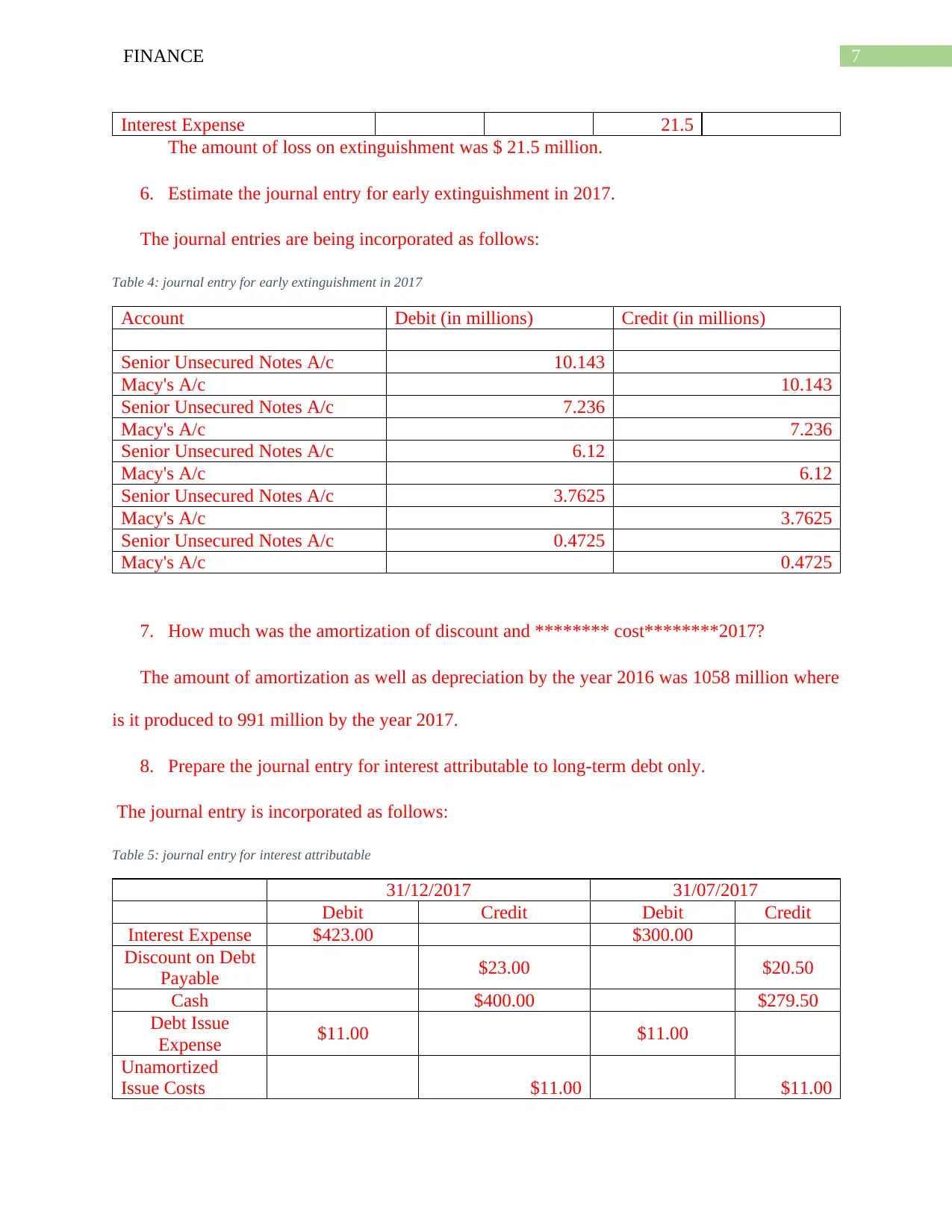
7FINANCE
Interest Expense 21.5
The amount of loss on extinguishment was $ 21.5 million.
6. Estimate the journal entry for early extinguishment in 2017.
The journal entries are being incorporated as follows:
Table 4: journal entry for early extinguishment in 2017
Account Debit (in millions) Credit (in millions)
Senior Unsecured Notes A/c 10.143
Macy's A/c 10.143
Senior Unsecured Notes A/c 7.236
Macy's A/c 7.236
Senior Unsecured Notes A/c 6.12
Macy's A/c 6.12
Senior Unsecured Notes A/c 3.7625
Macy's A/c 3.7625
Senior Unsecured Notes A/c 0.4725
Macy's A/c 0.4725
7. How much was the amortization of discount and ******** cost********2017?
The amount of amortization as well as depreciation by the year 2016 was 1058 million where
is it produced to 991 million by the year 2017.
8. Prepare the journal entry for interest attributable to long-term debt only.
The journal entry is incorporated as follows:
Table 5: journal entry for interest attributable
31/12/2017 31/07/2017
Debit Credit Debit Credit
Interest Expense $423.00 $300.00
Discount on Debt
Payable $23.00 $20.50
Cash $400.00 $279.50
Debt Issue
Expense $11.00 $11.00
Unamortized
Issue Costs $11.00 $11.00
Interest Expense 21.5
The amount of loss on extinguishment was $ 21.5 million.
6. Estimate the journal entry for early extinguishment in 2017.
The journal entries are being incorporated as follows:
Table 4: journal entry for early extinguishment in 2017
Account Debit (in millions) Credit (in millions)
Senior Unsecured Notes A/c 10.143
Macy's A/c 10.143
Senior Unsecured Notes A/c 7.236
Macy's A/c 7.236
Senior Unsecured Notes A/c 6.12
Macy's A/c 6.12
Senior Unsecured Notes A/c 3.7625
Macy's A/c 3.7625
Senior Unsecured Notes A/c 0.4725
Macy's A/c 0.4725
7. How much was the amortization of discount and ******** cost********2017?
The amount of amortization as well as depreciation by the year 2016 was 1058 million where
is it produced to 991 million by the year 2017.
8. Prepare the journal entry for interest attributable to long-term debt only.
The journal entry is incorporated as follows:
Table 5: journal entry for interest attributable
31/12/2017 31/07/2017
Debit Credit Debit Credit
Interest Expense $423.00 $300.00
Discount on Debt
Payable $23.00 $20.50
Cash $400.00 $279.50
Debt Issue
Expense $11.00 $11.00
Unamortized
Issue Costs $11.00 $11.00
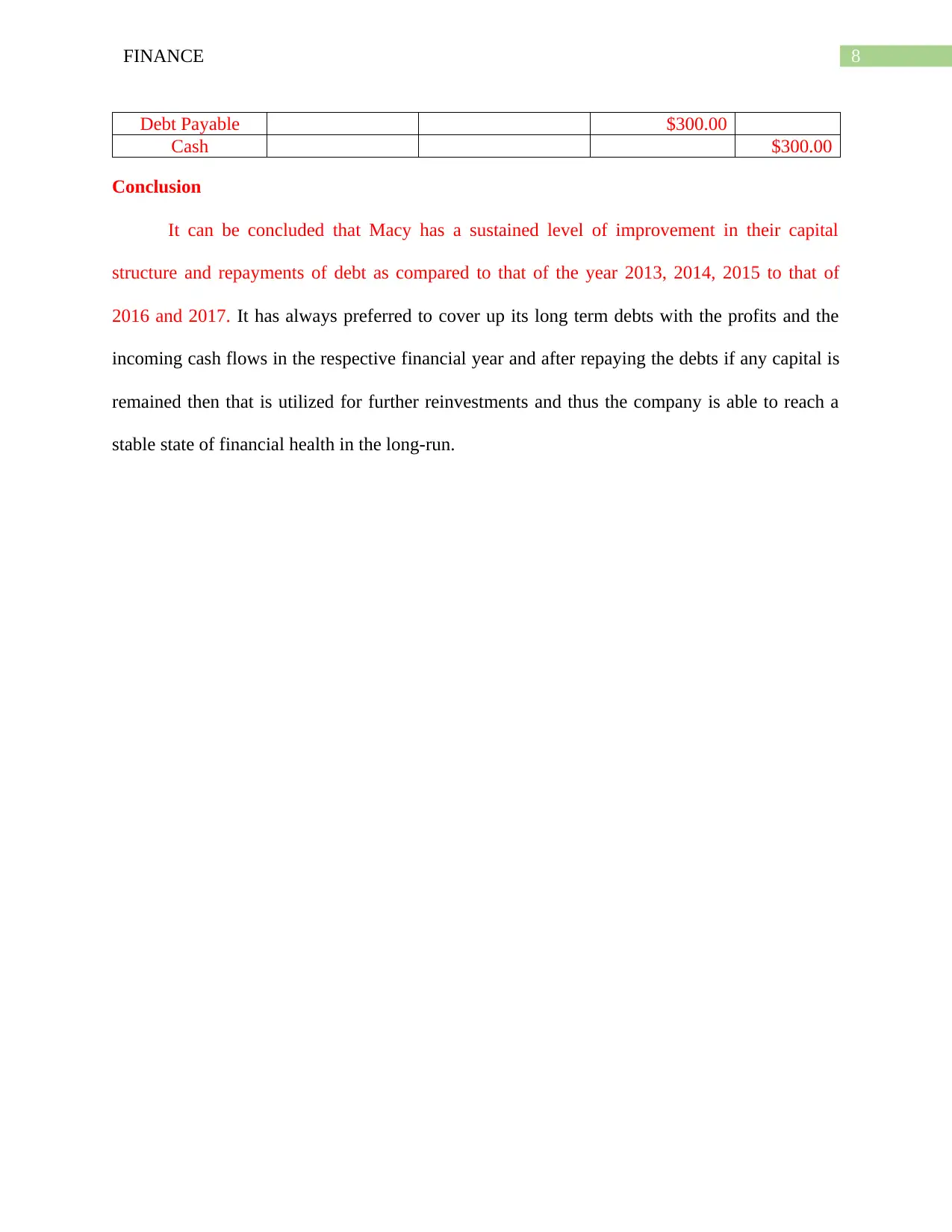
8FINANCE
Debt Payable $300.00
Cash $300.00
Conclusion
It can be concluded that Macy has a sustained level of improvement in their capital
structure and repayments of debt as compared to that of the year 2013, 2014, 2015 to that of
2016 and 2017. It has always preferred to cover up its long term debts with the profits and the
incoming cash flows in the respective financial year and after repaying the debts if any capital is
remained then that is utilized for further reinvestments and thus the company is able to reach a
stable state of financial health in the long-run.
Debt Payable $300.00
Cash $300.00
Conclusion
It can be concluded that Macy has a sustained level of improvement in their capital
structure and repayments of debt as compared to that of the year 2013, 2014, 2015 to that of
2016 and 2017. It has always preferred to cover up its long term debts with the profits and the
incoming cash flows in the respective financial year and after repaying the debts if any capital is
remained then that is utilized for further reinvestments and thus the company is able to reach a
stable state of financial health in the long-run.
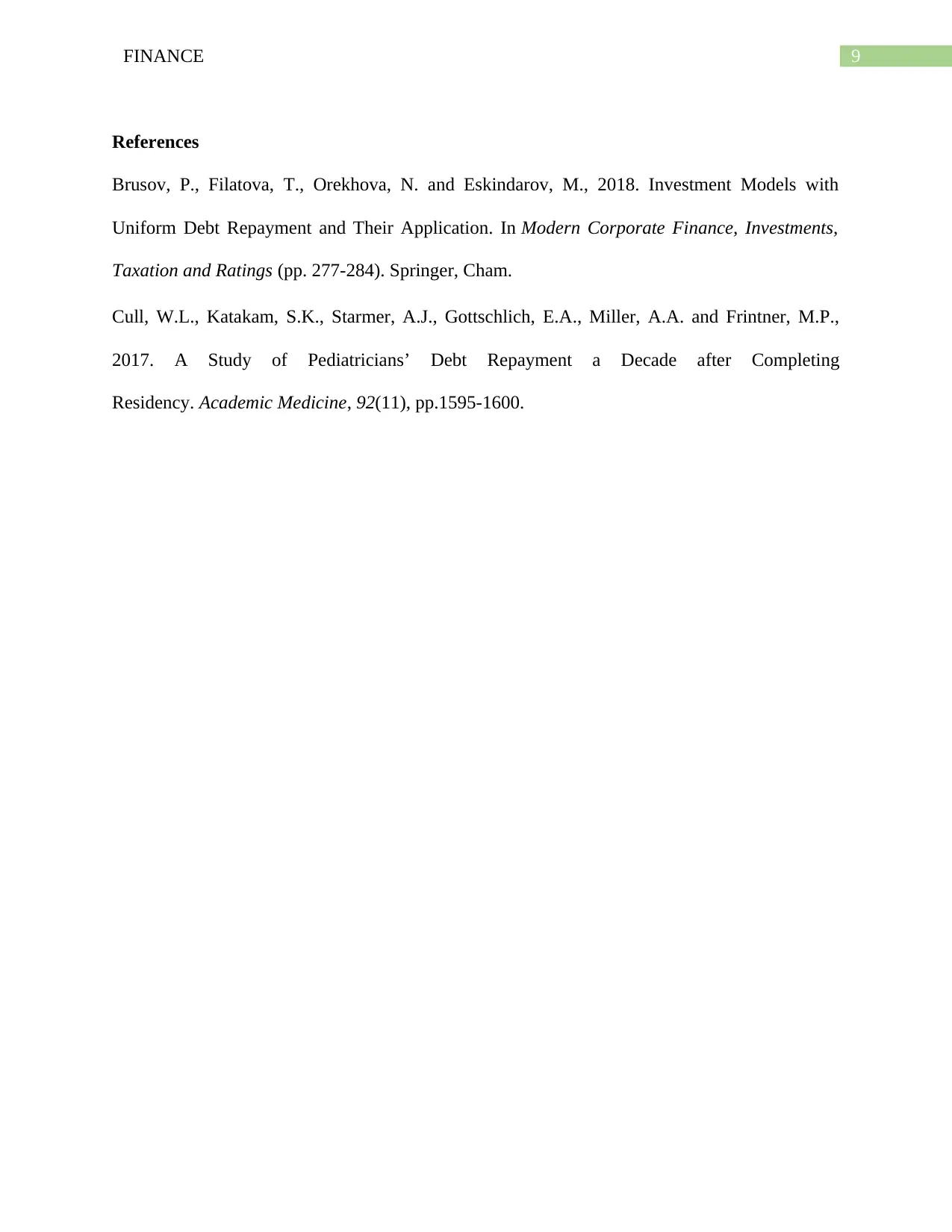
9FINANCE
References
Brusov, P., Filatova, T., Orekhova, N. and Eskindarov, M., 2018. Investment Models with
Uniform Debt Repayment and Their Application. In Modern Corporate Finance, Investments,
Taxation and Ratings (pp. 277-284). Springer, Cham.
Cull, W.L., Katakam, S.K., Starmer, A.J., Gottschlich, E.A., Miller, A.A. and Frintner, M.P.,
2017. A Study of Pediatricians’ Debt Repayment a Decade after Completing
Residency. Academic Medicine, 92(11), pp.1595-1600.
References
Brusov, P., Filatova, T., Orekhova, N. and Eskindarov, M., 2018. Investment Models with
Uniform Debt Repayment and Their Application. In Modern Corporate Finance, Investments,
Taxation and Ratings (pp. 277-284). Springer, Cham.
Cull, W.L., Katakam, S.K., Starmer, A.J., Gottschlich, E.A., Miller, A.A. and Frintner, M.P.,
2017. A Study of Pediatricians’ Debt Repayment a Decade after Completing
Residency. Academic Medicine, 92(11), pp.1595-1600.
1 out of 10
Related Documents
Your All-in-One AI-Powered Toolkit for Academic Success.
+13062052269
info@desklib.com
Available 24*7 on WhatsApp / Email
![[object Object]](/_next/static/media/star-bottom.7253800d.svg)
Unlock your academic potential
© 2024 | Zucol Services PVT LTD | All rights reserved.





